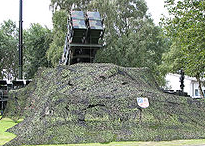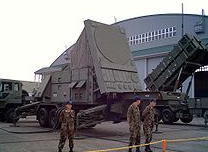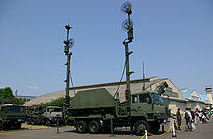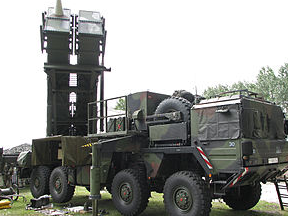
MIM-104 Patriot
USINFO | 2013-10-09 13:42
The MIM-104 Patriot is a surface-to-air missile (SAM) system, the primary of its kind used by the United States Army and several allied nations. It is manufactured by the Raytheon Company of the United States, and derives its name from the Radar component of the weapon system. The AN/MPQ-53 at the heart of the system is known as the "Phased Array Tracking Radar to Intercept On Target" or the bacronym PATRIOT. The Patriot System replaced the Nike Hercules system as the U.S. Army's primary High to Medium Air Defense (HIMAD) system, and replaced the MIM-23 Hawk system as the U.S. Army's medium tactical air defense system. In addition to these roles, Patriot has been given the function of the U.S. Army's anti-ballistic missile (ABM) system, which is now Patriot's primary mission.
Patriot uses an advanced aerial interceptor missile and high performance radar systems. Patriot was developed at Redstone Arsenal in Huntsville, Alabama, which had previously developed the Safeguard ABM system and its component Spartan and Sprint missiles. The symbol for Patriot is a drawing of a Revolutionary War-era Minuteman.
Patriot systems have been sold to Taiwan, Egypt, Germany, Greece, Israel, Japan, Kuwait, the Netherlands, Saudi Arabia, United Arab Emirates,[3]Jordan and Spain. Poland hosts training rotations of a battery of U.S. Patriot launchers. It was first deployed in Morąg in 24 May 2010 but has since been moved to Toruń and Ustka.[4] South Korea also purchased several second-hand Patriot systems from Germany after North Korea test-launched ballistic missiles to the Sea of Japan and proceeded with underground nuclear testing in 2006.[5] On 4 December 2012, NATO authorized the deployment of Patriot missile launchers in Turkey to protect the country from missiles fired in the civil war in neighboring Syria.
Introduction
On 15 October 1964 the U.S. Secretary of Defense directed that the Army Air Defense System for the 1970s (AADS-70s) program name be changed to Surface-to-Air Missile, Development (SAM-D).[7] In 1975 the SAM-D missile successfully engaged a drone at the White Sands Missile Range. During 1976, it was renamed the PATRIOT Air Defense Missile System. The MIM-104 Patriot would combine several new technologies, including the phased array radar and track-via-missile guidance. Full-scale development of the system began in 1976 and it was deployed in 1984. Patriot was used initially as an anti-aircraft system, but during 1988 it was upgraded to provide limited capability against tactical ballistic missiles (TBM) as PAC-1 (Patriot Advanced Capability-1). The most recent upgrade, called PAC-3, is a nearly total system redesign, intended from the outset to engage and destroy tactical ballistic missiles.Patriot equipment
The Patriot system has four major operational functions: communications, command and control, radar surveillance, and missile guidance. The four functions combine to provide a coordinated, secure, integrated, mobile air defense system.
The Patriot system is modular and highly mobile. A battery-sized element can be emplaced in less than 1 hour. All components, consisting of the fire control section (radar set, engagement control station, antenna mast group, electric power plant) and launchers, are truck- or trailer-mounted. The radar set and launchers (with missiles) are mounted on M860 semi-trailers, which are towed by M983 HEMTTs.
Missile reload is accomplished using a M985 GMT HEMTT truck with a Hiab crane on the back. This crane is larger than the standard Grove cranes found on regular M977 and M985 HEMTT cargo body trucks. This truck/ crane, called a Guided Missile Transporter (GMT), removes spent missile canisters from the launcher and then replaces them with fresh missiles. Because the crane nearly doubles the height of the HEMTT when not stowed, crews informally refer to it as the "scorpion tail." A standard M977 HEMTT with a regular-sized crane is sometimes referred to as the Large Repair Parts Transporter (LRPT).

German Patriot system with camouflage
The heart of the Patriot battery is the fire control section, consisting of the AN/MPQ-53 or -65 Radar Set, the AN/MSQ-104 Engagement Control Station (ECS), the OE-349 Antenna Mast Group (AMG), and the EPP-III Electric Power Plant. The system's missiles are transported on and launched from the M901 Launching Station, which can carry up to four PAC-2 missiles or up to sixteen PAC-3 missiles. A Patriot battalion is also equipped with the Information Coordination Central (ICC), a command station designed to coordinate the launches of a battalion and uplink Patriot to the JTIDS or MIDS network.The AN/MPQ-53 and AN/MPQ-65 Radar Set
The AN/MPQ-53/65 Radar Set is a passive electronically scanned array radar equipped with IFF, electronic counter-countermeasure (ECCM), and track-via-missile(TVM) guidance subsystems.
The AN/MPQ-53 Radar Set equips PAC-2 units, while the AN/MPQ-65 Radar Set equips PAC-3 units. The main difference between these two radars is the addition of a second traveling wave tube (TWT), which gives the -65 radar increased search, detection, and tracking capability. The radar's antenna array consists of over 5,000 elements that "flash" the radar's beam many times per second. Additionally, the radar's antenna array contains an IFF interrogator subsystem, a TVM array, and at least one "sidelobe canceller" (SLC), which is a small array designed to decrease interference that might affect the radar. Patriot's radar is somewhat unique in that it is a "detection-to-kill" system, meaning that a single unit performs all search, identification, track, and engagement functions. This is in contrast to most SAM systems, where several different radars are necessary to perform all functions necessary to detect and engage targets.

The beam created by the Patriot's flat phased array radar is comparatively narrow and highly agile compared to a moving dish. This characteristic gives the radar the ability to detect small, fast targets like ballistic missiles, or low radar cross section targets such as stealth aircraft or cruise missiles. Additionally, the power and agility of Patriot's radar is highly resistant to countermeasures, including electronic countermeasures (ECM) radar jamming andradar warning receiver (RWR) equipment. Patriot is capable of quickly jumping between frequencies to resist jamming.

AN/MSQ-104 vehicle of a Dutch Patriot unit
The AN/MSQ-104 Engagement Control Station (ECS) is the nerve center of the Patriot firing battery, costing approximately $6 million US dollars per unit.[8] The ECS consists of a shelter mounted on the bed of an M927 5-Ton Cargo Truck or on the bed of a Light Medium Tactical Vehicle (LMTV) cargo truck. The main sub-components of the ECS are the Weapons Control Computer (WCC), the Data Link Terminal (DLT), the UHF communications array, the Routing Logic Radio Interface Unit (RLRIU), and the two manstations that serve as the system's man-to-machine interface. The ECS is air conditioned, pressurized (to resist chemical/biological attack), and shielded against electromagnetic pulse (EMP) or other such electromagnetic interference. The ECS also contains severalSINCGARS radios to facilitate voice communications.The WCC is the main computer within the Patriot system. It is a 24-bit parallel militarized computer with fixed and floating point capability. It is organized in a multiprocessor configuration that operates at a maximum clock rate of 6 megahertz. This computer controls the operator interface, calculates missile intercept algorithms, and provides limited fault diagnostics. Compared to modern personal computers, it has somewhat limited processing power, although it has been upgraded several times during Patriot's service life.
The DLT connects the ECS to Patriot's Launching Stations. It uses either a SINCGARS radio or fiber optic cables to transmit encrypted data between the ECS and the launchers. Through the DLT, the system operators can remotely emplace, slew or stow launchers, perform diagnostics on launchers or missiles, and fire missiles.
The UHF communications array consists of three UHF radio "stacks" and their associated patching and encrypting equipment. These radios are connected to the antennas of the OE-349 Antenna Mast Group, which are used to create UHF "shots" between sister Patriot batteries and their associated ICC. This creates a secure, real-time data network (known as PADIL, Patriot Data Information Link) that allows the ICC to centralize control of its subordinate firing batteries.
The RLRIU functions as the primary router for all data coming into the ECS. The RLRIU gives a firing battery an address on the battalion data network, and sends/receives data from across the battalion. It also "translates" data coming from the WCC to the DLT, facilitating communication with the launchers.
Patriot's crew stations are referred to as Manstation 1 and 3 (MS1 and MS3). These are the stations where Patriot operators interface with the system. The manstations consist of a monochrome (green and black) screen surrounded by various Switch Indicators. Each manstation also has a traditional QWERTY keyboard and isometric stick, a tiny joystick that functions much like a PC mouse. It is through these switch indicators and the Patriot user interface software that the system is operated.
The OE-349 Antenna Mast Group

Antenna Mast Group
The OE-349 Antenna Mast Group (AMG) is mounted on an M927 5-Ton Cargo Truck. It includes four 4 kW antennas in two pairs on remotely controlled masts. Emplacement of the AMG can have no greater than a 0.5 degree roll, and a 10 degree crossroll. The antennas can be controlled in azimuth, and the masts can be elevated up to 100 feet 11 inches (30.76 m) above ground level. Mounted at the base of each pair of antennas are two high-power amplifiers associated with the antennas and the radios in the collocated shelter. It is through these antennas that the ECS and ICC send their respective UHF "shots" to create the PADIL network. The polarity of each shot can be changed by adjusting the "feedhorn" to a vertical or horizontal position. This enables a greater chance of communication shots reaching their intended target when terrain obstacles may otherwise obscure the signal.The EPP-III Electric Power Plant
The EPP-III Diesel- Electric Power Plant (EPP) is the power source for the ECS and Radar. The EPP consists of two 150 kilowatt diesel engines with 400 hertz, 3-phase generators that are interconnected through the power distribution unit. The generators are mounted on a modified M977 HEMTT. Each EPP has two 75-gallon (280 L) fuel tanks and a fuel distribution assembly with grounding equipment. Each diesel engine can operate more than 8 hours with a full fuel tank. The EPP delivers its power to the Radar and ECS through cables stored in reels alongside the generators. Additionally it powers the AMG via a cable routed through the ECS.
The M901 Launching Station
The M901 Launching Stations are remotely-operated, self-contained units. The ECS controls operation of the launchers through each launcher's DLT, via fiber optic or VHF (SINCGARS) data link.
Integral leveling equipment permits emplacement on slopes of up to 10 degrees. Each launcher is trainable in azimuth and elevates to a fixed, elevated launch position. Precise aiming of the launcher before launch is not necessary; thus, no extra lags are introduced into system reaction time. Each launcher is also capable of providing detailed diagnostics to the ECS via the data link.
The launching station contains four major equipment subsystems: the launcher generator set, the launcher electronics module (LEM), the launcher mechanics assembly (LMA), and the launcher interconnection group (LIG). The generator set consists of a 15 kW, 400 Hz generator that powers the launcher. The LEM is used for the real-time implementation of launcher operations requested via data link from the ECS. The LMA physically erects and rotates the launcher's platform and its missiles. The LIG connects the missiles themselves to the launcher via the Launcher Missile Round Distributor (LMRD).
| Patriot missile | |
 Four Patriot missiles can be fired from the highly mobile TEL |
|
| Type | Surface-to-air missile |
| Place of origin |
 United States United States |
| Production history | |
| Designer | Raytheon |
| Unit cost | US$ 1 to 6 million [9] |
| Number built | over 8,600[1] |
| Variants | Standard, ASOJ/SOJC, PAC-2, PAC-2 GEM, GEM/C, GEM/T (or GEM+) and PAC-3 |
| Specifications (PAC-1[1]) | |
| Weight | 700 kg (1,500 lb) |
| Length | 5,800 mm (19 ft 0 in) |
| Diameter | 410 mm (16 in) |
|
|
|
| Warhead | M248 Composition B HE blast/fragmentation with two layers of pre-formed fragments and Octol 75/25 HE blast/fragmentation |
| Warhead weight | 200 lb (90 kg) |
|
Detonation mechanism |
Proximity fuze |
|
|
|
| Wingspan | 920 mm (3 ft 0 in) |
| Propellant | Solid-fuel rocket |
|
Operational range |
PAC - 1 :70 km PAC - 2 :160 km PAC - 3 :20 km against ballistic missile[10] |
| Flight altitude | 79,500 feet (24,200 m), 275,500 feet (84,000 m) only PAC - 1 launched from F-15C (never finished) |
| Speed | Mach 5.0 |
|
Guidance system |
Radio command with Track Via Missile semi-active homing |
|
Launch platform |
mobile trainable four-round semi-trailer |
The first fielded variant was the round MIM-104A, "Standard." It was optimized solely for engagements against aircraft and had very limited capability against ballistic missiles. It had a range of 70 km (43 mi), and a speed in excess of Mach 3.[11] The MIM-104B "anti-standoff jammer" (ASOJ) is a missile designed to seek out and destroy ECM emitters.
The MIM-104C PAC-2 missile was the first Patriot missile that was optimized for ballistic missile engagements. The GEM series of missiles (MIM-104D/E) are further refinements of the PAC-2 missile. The PAC-3 missile is a new interceptor, featuring a Ka band active radar seeker, employing "hit-to-kill" interception (in contrast to previous interceptors' method of exploding in the vicinity of the target, destroying it with shrapnel), and several other enhancements which dramatically increase its lethality against ballistic missiles. It has a substantially lower range of 15 km.[11] The specific information for these different kinds of missiles are discussed in the "Variants" section.
Share this page




















